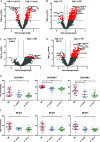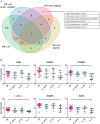Proteomic Analysis of FFPE Tissue Samples Identifies Potential Molecular Mechanisms Mediating Resistance to Radiotherapy in Rectal Cancer
- PMID: 40574313
- PMCID: PMC12322959
- DOI: 10.1021/acs.jproteome.5c00114
Proteomic Analysis of FFPE Tissue Samples Identifies Potential Molecular Mechanisms Mediating Resistance to Radiotherapy in Rectal Cancer
Abstract
Chemoradiation prior to surgery in locally advanced rectal cancer is the current standard therapy but is not effective in all rectal cancer patients. Prognostic markers supporting patient stratification with respect to clinical response would therefore be desirable. The aim of this study was to investigate pathophysiological mechanisms underlying radioresistance and to identify potential prognostic markers by comparative proteome profiling. Therefore, formalin fixed paraffin-embedded tissue (FFPE) samples from rectal tumors (n = 50) and normal control tissue (n = 39) of nonresponders and responders to neoadjuvant chemoradiation were analyzed. As a result, 1685 robustly identified proteins were further evaluated. Comparing tumor with corresponding control samples revealed 221 differentially expressed proteins (FDR < 0.05) with FTL, PCOLCE, and RCN3 being most striking in tumor tissue. CEACAM 1, 5, and 6, as well as MCM protein complex components, were significantly up-regulated in tumor tissue of nonresponders. The autophagic activity-related and DNA damage repair proteins TOM1, CAPNS1, TP53BP1, HS1BP3, as well as COTL1 and DCPS, discriminated non- and nearly complete from complete responders. In the tumor-surrounding tissue of nonresponders, the innate immune response-suppressing protein CD55 was found specifically up-regulated. These proteins may serve as prognostic markers and potential therapeutic targets, requiring further validation in prospective studies.
Keywords: DNA damage repair; FFPE tissue; LC-MS; autophagic activity; colorectal cancer; proteome profiling; radioresistance; radiotherapy; resistance mechanisms; tumor-associated stroma.
Figures




References
MeSH terms
Substances
LinkOut - more resources
Full Text Sources
Research Materials
Miscellaneous

